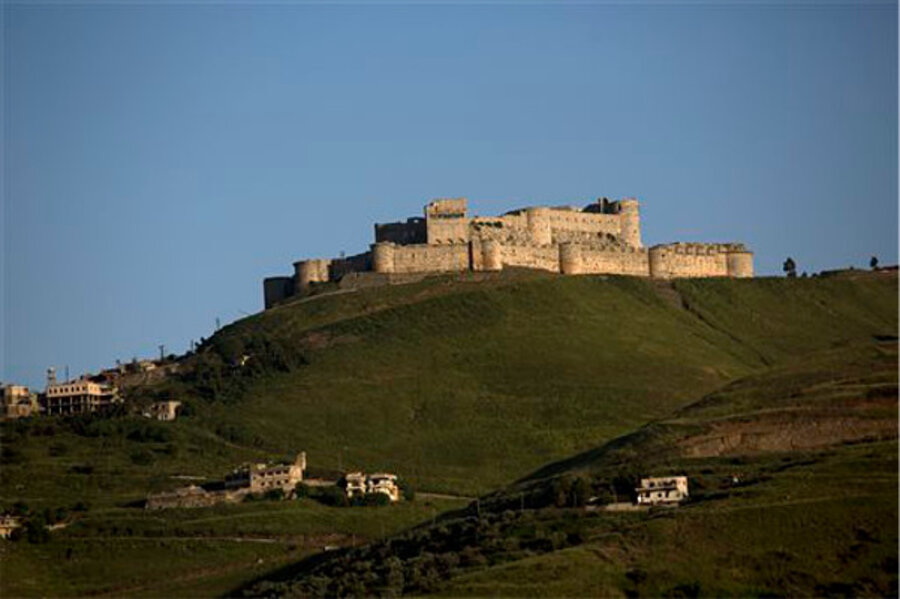Crac des Chevaliers: Priceless castle battered by Syria's civil war
Loading...
| HOSN, Syria
The Crac des Chevaliers once held off a siege by the Muslim warrior Saladin some 900 years ago, but today bears the wounds of modern warfare: heavy artillery damaged its walls, an airstrike punctured its roof, and shrapnel tore through its religious artifacts.
From its towering hilltop perch in western Syria, the world's best preserved medieval Crusader castle has fallen victim to the chaos of Syria's civil war as rebels fight to topple President Bashar Assad. The damage done to the majestic stone structure, listed as a UNESCO World Heritage site, shows that the warring sides will stop at nothing, including the destruction of the country's rich heritage, to hold on to power or territory.
Journalists from The Associated Press reconstructed the battle for Crac des Chevaliers after talking to Syrian soldiers and local residents during a rare trip by Western media to the castle since its capture by government troops in March. They talked of residents of Hosn and rebels using the castle walls as a last refuge, much like the Crusaders before them.
The Crac des Chevaliers, some 25 miles west of Homs and just north of the Lebanese border, caught the eye of a young T.E. Lawrence before he became Lawrence of Arabia. Lawrence lauded its beauty and called it one of the world's greatest castles. It dominates the surrounding valley and terraced hills below and once was one of the crown jewels of Syrian tourism before its 3-year-old conflict began.
It is like many of the country's most significant historical sites, caught in the crossfire in a conflict that activists say has killed more than 150,000 people. Some sites have been turned into military bases. Shelling has smashed historic mosques, churches and markets. Looters have stolen artifacts from excavations and museums.
About two years ago, Assad's forces identified the Sunni-populated village of Hosn as backing the rebels. They began an armed blockade that allowed no one to leave or go inside. The government said Hosn harbored foreign, al-Qaida-linked armed insurgents who terrorized neighboring, mostly Christian villages.
"The terrorists killed and kidnapped people and even chopped off their heads," said a Syrian army officer, using the government term for the insurgents. "We had to stop them at any cost."
He spoke on condition of anonymity as he wasn't authorized to speak publicly. His claim could not be independently verified and Syrian government officials accompanied AP journalists on their trip in the region.
Throughout the war, Assad's government has employed armed siege tactics with a devastating effect: shelling and starving fighters and civilians alike in opposition-held areas into submission or flight.
Under the heavy bombardment last winter, Hosn's population of around 9,000 people had nowhere to go but up the hill to the castle. Some fled to neighboring Lebanon in a daring dash through the army blockade. Hundreds barricaded themselves inside the castle — men, women and children.
Among them were dozens of rebel fighters who occasionally lobbed mortar shells from inside the tall walls, hitting nearby Christian villages, government soldiers and locals say.
The insurgents are overwhelmingly from the country's Sunni majority. Shiite Muslims and Christian minorities have either remained neutral or supported Assad, fearing for their fate should hard-liners come to power.
Those who found shelter inside the citadel ate little food they had taken with them, or sneaked out at night to search for anything that can be cooked, including cats and dogs. For seven months, they slept in the tiny church inside a walled compound, or in huge and dark stone halls used as horse stables by the Crusaders in the 12th century.
Mattresses and blankets, together with clothes, shoes and gas cookers lay scattered on damp stone and soil floors inside the castle when AP journalists recently visited it. Pages from a copy of the Quran fluttered in the breeze inside the church, which was turned into a mosque when Ottomans captured the fortress in the 13th century.
The villagers apparently hoped that castle's thick walls and its historic importance would prevent the Syrian army from further shelling. It didn't.
In March, during a massive government offensive against opposition strongholds on the border with Lebanon, Syrian jets unleashed a series of airstrikes. Heavy cannon fire pummeled the castle walls, with shells causing some ancient stone structures to crumble. Some of the shells ricocheted against the mighty stone structures, leaving deep marks on the historic citadel.
The army did not stop there. Its tanks went house to house in the empty village, methodically destroying each.
The smell of burned rubble lingered in the air. A legless sofa stood in front of the El Hasna shoe store where looters left only empty shoe boxes. An old TV set, a gold colored chandelier, a wooden bed frame and a wrecked refrigerator littered the main Al Karamah street. Destroyed cars stood parked inside garages of the sagging homes, their metal shutters twisted and dotted by shrapnel.
About 300 villagers and rebels were killed in the offensive, hundreds more were wounded while thousands managed to flee under fire across the border to Lebanon, according to government figures. Hundreds surrendered or were captured.
"A lot of people have been killed by the terrorists," saud Rami Sarheed, a 23-year-old Christian from the nearby village of Nasra. The government offensive "had to be done so that Syria returns to normal."
But what normal is remains in question in this now ghostly village, where two olive-green Syrian army tanks hoisting large government flags stand guard on the main road.
Copyright 2014 The Associated Press. All rights reserved. This material may not be published, broadcast, rewritten or redistributed.







